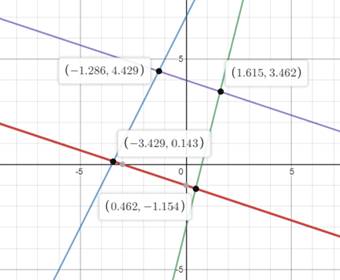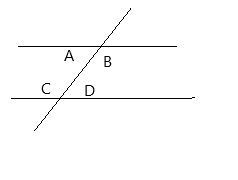
Concept explainers
(a)
To find: the shapes of line form by the graph with explanation.
(a)
Answer to Problem 42E
It formed a trapezoid, which is a quadrilateral with no side parallel.
Explanation of Solution
Given:
Concept used:
Graph can be draw using graphing calculator like Desmos graphing calculator.
The straight lines form an intersection with one another or it is parallel to each other.
Calculation:
The functions are
The graph of the functions is:

Hence, the shape formed a trapezoid, which is a quadrilateral with no side parallel.
(b)
To find: the conjecture about the equations of parallel lines.
(b)
Answer to Problem 42E
In the case the two parallel lines are
Explanation of Solution
Given:
Concept used:
Conjecture angle
Then the two lines are parallel to each other.
Calculation:
The conjecture is angle

Hence, In the case the two parallel lines are
Chapter 3 Solutions
BIG IDEAS MATH Integrated Math 1: Student Edition 2016
- Numerical anarrow_forward1. Prove the following arguments using the rules of inference. Do not make use of conditional proof. (а) а → (ЪЛс) ¬C ..¬a (b) (pVq) → →r יור (c) (c^h) → j ¬j h (d) s→ d t d -d ..8A-t (e) (pVg) (rv¬s) Лѕ קר .'arrow_forwardThe graph of f(x) is given below. Select each true statement about the continuity of f(x) at x = 1. Select all that apply: ☐ f(x) is not continuous at x = 1 because it is not defined at x = 1. ☐ f(x) is not continuous at x = 1 because lim f(x) does not exist. x+1 ☐ f(x) is not continuous at x = 1 because lim f(x) ‡ f(1). x+→1 ☐ f(x) is continuous at x = 1.arrow_forward
- 2. Consider the following argument: (a) Seabiscuit is a thoroughbred. Seabiscuit is very fast. Every very fast racehorse can win the race. .. Therefore, some thoroughbred racehorse can win the race. Let us define the following predicates, whose domain is racehorses: T(x) x is a thoroughbred F(x) x is very fast R(x) x can win the race : Write the above argument in logical symbols using these predicates. (b) Prove the argument using the rules of inference. Do not make use of conditional proof. (c) Rewrite the proof using full sentences, avoiding logical symbols. It does not need to mention the names of rules of inference, but a fellow CSE 16 student should be able to understand the logical reasoning.arrow_forwardFind the inverse of the matrix, or determine that the inverse does not exist for: € (b) 7 -12 240 1 1 1 (c) 2 3 2 2 17 036 205 20 (d) -1 1 2 1 T NO 1 0 -1 00 1 0 02 (e) 1 0 00 0 0 1 1arrow_forward4. Prove the following. Use full sentences. Equations in the middle of sentences are fine, but do not use logical symbols. (a) (b) (n+3)2 is odd for every even integer n. It is not the case that whenever n is an integer such that 9 | n² then 9 | n.arrow_forward
- 3. (a) (b) Prove the following logical argument using the rules of inference. Do not make use of conditional proof. Vx(J(x)O(x)) 3x(J(x) A¬S(x)) . ·.³x(O(x) ^ ¬S(x)) Rewrite the proof using full sentences, avoiding logical symbols. It does not need to mention the names of rules of inference, but a fellow CSE 16 student should be able to understand the logical reasoning.arrow_forward3. Pleasearrow_forwardWhat does the margin of error include? When a margin of error is reported for a survey, it includes a. random sampling error and other practical difficulties like undercoverage and non-response b. random sampling error, but not other practical difficulties like undercoverage and nonresponse c. practical difficulties like undercoverage and nonresponse, but not random smapling error d. none of the above is corretarrow_forward
 Discrete Mathematics and Its Applications ( 8th I...MathISBN:9781259676512Author:Kenneth H RosenPublisher:McGraw-Hill Education
Discrete Mathematics and Its Applications ( 8th I...MathISBN:9781259676512Author:Kenneth H RosenPublisher:McGraw-Hill Education Mathematics for Elementary Teachers with Activiti...MathISBN:9780134392790Author:Beckmann, SybillaPublisher:PEARSON
Mathematics for Elementary Teachers with Activiti...MathISBN:9780134392790Author:Beckmann, SybillaPublisher:PEARSON
 Thinking Mathematically (7th Edition)MathISBN:9780134683713Author:Robert F. BlitzerPublisher:PEARSON
Thinking Mathematically (7th Edition)MathISBN:9780134683713Author:Robert F. BlitzerPublisher:PEARSON Discrete Mathematics With ApplicationsMathISBN:9781337694193Author:EPP, Susanna S.Publisher:Cengage Learning,
Discrete Mathematics With ApplicationsMathISBN:9781337694193Author:EPP, Susanna S.Publisher:Cengage Learning, Pathways To Math Literacy (looseleaf)MathISBN:9781259985607Author:David Sobecki Professor, Brian A. MercerPublisher:McGraw-Hill Education
Pathways To Math Literacy (looseleaf)MathISBN:9781259985607Author:David Sobecki Professor, Brian A. MercerPublisher:McGraw-Hill Education





